
Avionics are the electronic systems used on aircraft, artificial satellites, and spacecraft. Avionic systems include communications, navigation, the display and management of multiple systems, and the hundreds of systems that are fitted to aircraft to perform individual functions. These can be as simple as a searchlight for a police helicopter or as complicated as the tactical system for an airborne early warning platform. The term avionics is a portmanteau of the words aviation and electronics.

Artillery is a class of heavy military ranged weapons built to launch munitions far beyond the range and power of infantry firearms. Early artillery development focused on the ability to breach defensive walls and fortifications during sieges, and led to heavy, fairly immobile siege engines. As technology improved, lighter, more mobile field artillery cannons developed for battlefield use. This development continues today; modern self-propelled artillery vehicles are highly mobile weapons of great versatility generally providing the largest share of an army's total firepower.

A bomber is a combat aircraft designed to attack ground and naval targets by dropping air-to-ground weaponry, launching torpedoes, or deploying air-launched cruise missiles. The first use of bombs dropped from an aircraft occurred in the Italo-Turkish War, with the first major deployments coming in the First World War and Second World War by all major airforces causing devastating damage to cities, towns, and rural areas. The first purpose built bombers were the Italian Caproni Ca 30 and British Bristol T.B.8, both of 1913. Some bombers were decorated with nose art or victory markings.

The United States Air Force (USAF) is the air service branch of the United States Armed Forces. It is one of the eight U.S. uniformed services. Initially formed as a part of the United States Army on 1 August 1907, the USAF was established as a separate branch of the U.S. Armed Forces on 18 September 1947 with the passing of the National Security Act of 1947. It is the second youngest branch of the U.S. Armed Forces and the fourth in order of precedence. The U.S. Air Force articulates its core missions as air superiority, global integrated intelligence, surveillance and reconnaissance, rapid global mobility, global strike, and command and control.

A military aircraft is any fixed-wing or rotary-wing aircraft that is operated by a legal or insurrectionary armed service of any type. Military aircraft can be either combat or non-combat:
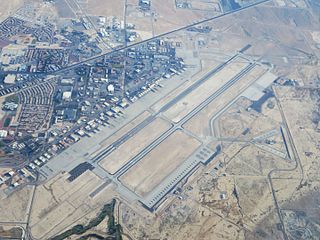
Nellis Air Force Base is a United States Air Force installation in southern Nevada with military schools and more squadrons than any other USAF base. Nellis hosts air combat exercises such as Exercise Red Flag and close air support exercises such as Green Flag-West flown in "Military Operations Area (MOA) airspace", associated with the nearby Nevada Test and Training Range (NTTR). The base also has the Combined Air and Space Operations Center-Nellis.
Aerial warfare is the battlespace use of military aircraft and other flying machines in warfare. Aerial warfare includes bombers attacking enemy installations or a concentration of enemy troops or strategic targets; fighter aircraft battling for control of airspace; attack aircraft engaging in close air support against ground targets; naval aviation flying against sea and nearby land targets; gliders, helicopters and other aircraft to carry airborne forces such as paratroopers; aerial refueling tankers to extend operation time or range; and military transport aircraft to move cargo and personnel. Historically, military aircraft have included lighter-than-air balloons carrying artillery observers; lighter-than-air airships for bombing cities; various sorts of reconnaissance, surveillance and early warning aircraft carrying observers, cameras and radar equipment; torpedo bombers to attack enemy shipping; and military air-sea rescue aircraft for saving downed airmen. Modern aerial warfare includes missiles and unmanned aerial vehicles. Surface forces are likely to respond to enemy air activity with anti-aircraft warfare.

In military terminology a landing zone (LZ) is an area where aircraft can land.

Aircrew, also called flight crew, are personnel who operate an aircraft while in flight. The composition of a flight's crew depends on the type of aircraft, plus the flight's duration and purpose.

A loadmaster is an aircrew member on civilian aircraft or military transport aircraft tasked with the safe loading, transport and unloading of aerial cargoes. Loadmasters serve in the militaries and civilian airlines of many nations.

The Martin MGM-1 Matador was the first operational surface-to-surface cruise missile designed and built by the United States. It was developed after World War II, drawing upon their wartime experience with creating the Republic-Ford JB-2, a copy of the German V-1. The Matador was similar in concept to the V-1, but it included a radio command that allowed in-flight course corrections. This allowed accuracy to be maintained over greatly extended ranges of just under 1000 km. To allow these ranges, the Matador was powered by a small turbojet engine in place of the V-1's much less efficient pulsejet.
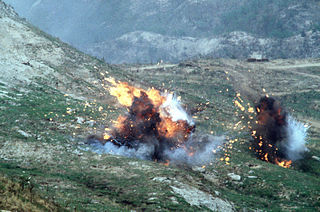
Tactical bombing is aerial bombing aimed at targets of immediate military value, such as combatants, military installations, or military equipment. This is in contrast to strategic bombing, or attacking enemy cities and factories to cripple future military production and enemy civilians' will to support the war effort, to debilitate the enemy's long-term capacity to wage war. A tactical bomber is a bomber aircraft with an intended primary role of tactical bombing, even though strategic bombers have been used in tactical bombing operations.

The Advanced Tactical Laser (ATL) program was a US military program to mount a high energy laser weapon on an aircraft, initially the AC-130 gunship, for use against ground targets in urban or other areas where minimizing collateral damage is important. The laser was a 100 kilowatt-class chemical oxygen iodine laser (COIL). It was expected to have a tactical range of approximately twenty kilometers and weigh about 5,000–7,000 kg. This program is distinct from the Airborne Laser, which was a much larger system designed to destroy enemy missiles in the boost phase.
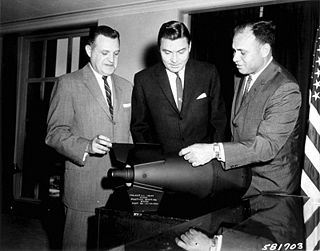
A tactical nuclear weapon (TNW) or non-strategic nuclear weapon is a nuclear weapon which is designed to be used on a battlefield in military situations mostly with friendly forces in proximity and perhaps even on contested friendly territory. Generally smaller in explosive power, they are defined in contrast to strategic nuclear weapons: which are designed to be mostly targeted in the enemy interior away from the war front against military bases, cities, towns, arms industries, and other hardened or larger-area targets to damage the enemy's ability to wage war.

The Cavalry Scout is the job title used to refer to someone who has achieved the military occupational specialty of 19D Armored Reconnaissance Specialist in the Combat Arms branch of the United States Army. As with all enlisted soldiers in the U.S. Cavalry, the person holding the Scout specialization will still be referred to as a ”Trooper”, the traditional colloquialism denoted in the Cavalry's Order of the Spur.
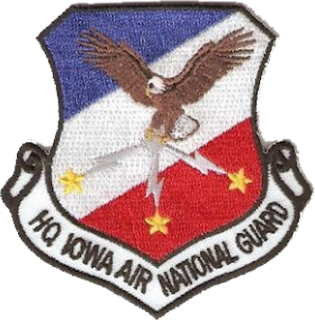
The Iowa Air National Guard is the aerial militia of the State of Iowa, United States of America. It is, along with the Iowa Army National Guard, an element of the Iowa National Guard.

An air observer or aerial observer is an aircrew member whose duties are predominantly reconnaissance. The term originated in the First World War in the British Royal Flying Corps, and was maintained by its successor, the Royal Air Force. An air observer's brevet was a single wing with an O at the root. Although today sometimes a manned aircraft is still utilised for aerial observation, industry and the military use both satellites and remotely piloted vehicles (RPV) for this function.
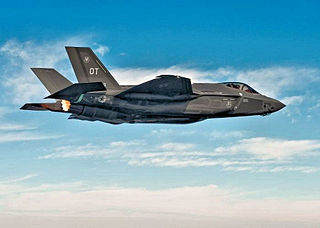
The 422d Test and Evaluation Squadron is a United States Air Force unit. It is assigned to the 53d Test and Evaluation Group, stationed at Nellis Air Force Base, Nevada. The squadron performs operational testing of all fighter aircraft and munitions entering and in operational use by Air Combat Command.

The Storm Search and Rescue Tactical Vehicle (SRTV) is an all-terrain light military vehicle developed by the United States. It was the winner of the Guardian Angel Air-Deployable Rescue Vehicle (GAARV) competition awarded by the Air Force Life Cycle Management Center (AFLCMC). The competition was named for the pararescuemen and combat rescue officers known as the "Guardian Angel Weapon System." The Storm SRTV is to be used by the United States Air Force Pararescue.

The Mars was a Soviet solid-fuel tactical missile system with a range of 7 to 18 km.


















